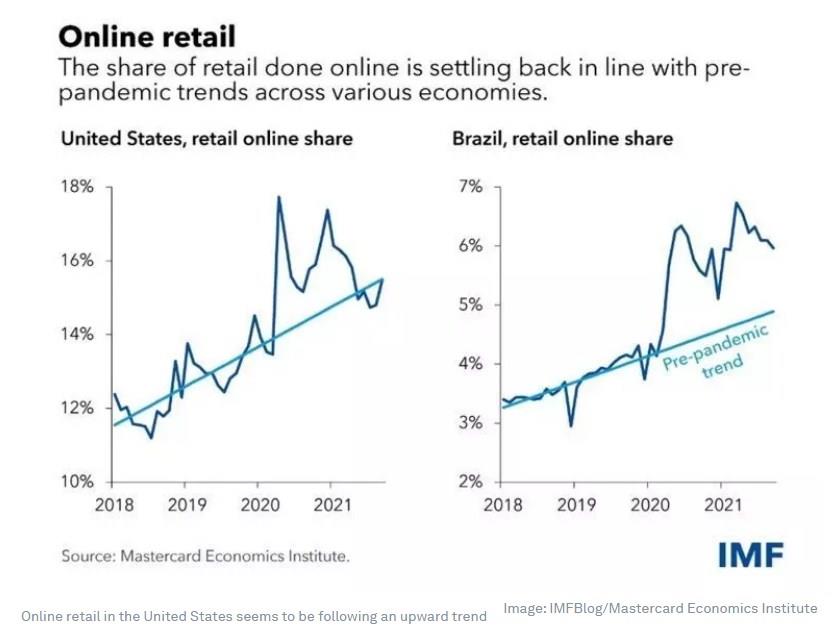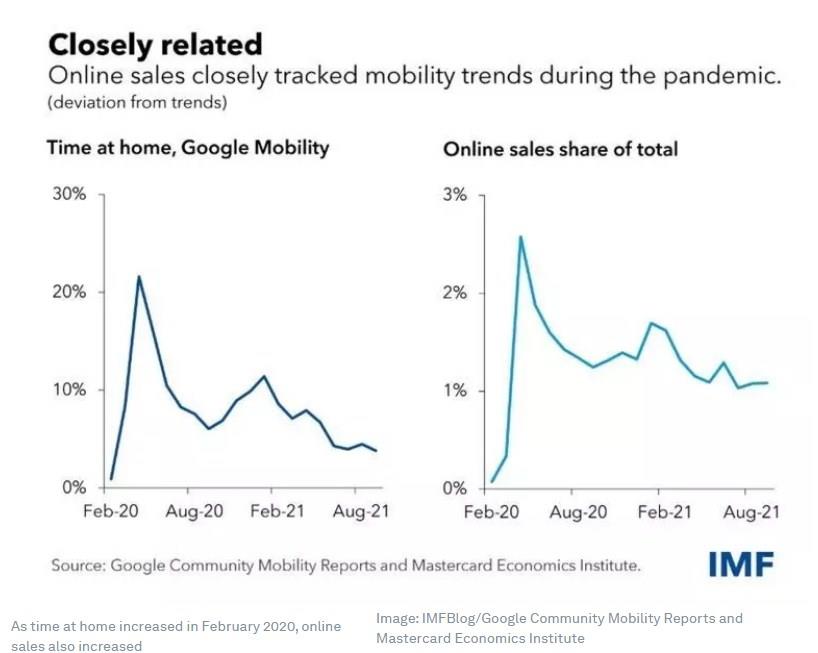by Joel Alcedo, Alberto Cavallo, Bricklin Dwyer, Prachi Mishra and Antonio Spilimbergo*
There’s no doubt that e-commerce helped many navigate the pandemic, from online shopping to curbside pickup to food delivery. But as we slowly emerge from lockdowns and other restrictions, it’s less clear how this shift to digital commerce may evolve across economies and industries.
This raises questions about how much digital consumption increased, whether the crisis widened the digital divide or spurred economies with little e-commerce to catch up, how permanent the shift to online sales will be, and what factors explain deviations between economies and sectors.
We investigated these questions in new research that uses a unique database of aggregated and anonymized transactions through the Mastercard network from across 47 countries from January 2018 to September 2021. We found that the share of online spending rose more in economies where e-commerce already played a large role—and that the increase is reversing as the pandemic recedes.
This research, a new partnership between Mastercard, the International Monetary Fund and Harvard Business School, shows how private-sector data can help advance empirical economics and will be the first in a series of such studies.
Variation across economies
On average, the online share of total spending rose sharply from 10.3 percent in 2019 to 14.9 percent at the peak of the pandemic, but then fell to 12.2 percent in 2021.
Though the latest online share of spending is higher than before the pandemic started, it’s only 0.6 percentage points above the growth trend for e-commerce had the crisis not happened. While most economies are now below those peak levels, there are still significant differences among countries.
The online share of spending is still above pre-pandemic trends in about half of economies, from large emerging economies such as Brazil and India to other middle-income countries like Bahrain and Jamaica. In all the others, including the United States and many advanced economies, the online shares are now either at or below the predicted pre-COVID trend levels. Those trends are estimated in each economy using a simple extrapolation of e-commerce’s path before the pandemic and reflects what would have been predicted in the absence of the crisis.

We find that e-commerce increased more in economies with a higher pre-COVID share of online transactions in total consumption, exacerbating the digital divide across economies. For example, Singapore, Canada and the United Kingdom had high shares to begin with, and their online penetration went up even more during the pandemic. On the other hand, countries like Brazil and Thailand had low online shares pre-COVID, and they experienced less of an acceleration.
How persistent was the effect on online sales? Strikingly, the latest data suggest that the spikes in online spending shares are gradually dissipating at the aggregate level.
The average online spending share at the peak of the crisis was 4.3 percentage points above the level that would have been predicted before it hit. This difference drops to only 0.3 point by the end of our sample period.
Pandemic restrictions, fiscal support
One explanation for the variation across economies, and in online share of spending, may be the difference across pandemic-related mobility restrictions. Not surprisingly, economies with stricter limits saw much higher online spending.
This was particularly true at the beginning of the crisis in the second quarter of 2020, when lockdowns severely curbed movement in most economies. However, as the pandemic continued, that correlation between restrictions and online spending weakened—consistent with the declining impact of lockdowns and other restrictions on economic activity over time.

In addition, fiscal support during the pandemic helped boost e-commerce penetration, likely by increasing consumption, which, in the presence of pandemic restrictions, could mostly be done online. Wealthier, more digitally mature economies also returned faster to pre-pandemic pace of online spending once the crisis receded.
Longer-lasting effects
One common narrative is that the pandemic accelerated digitalization, forcing consumers to learn how to shop online, and that this learning was here to stay. While our results support the quick uptake of e-commerce, the persistence of learning does not appear broad-based.
That said, we find significant variation by industry. The embrace of e-commerce appears to be particularly longer lasting in restaurants (more specifically in food delivery), health care (which includes telemedicine) and some categories of retail, including department stores, electronics, and clothing.
During the initial surge of the pandemic, there was a big demand for e-commerce relative to in-person commerce. Economies and sectors already familiar with some of the technologies were able to go online to a larger degree. While the pandemic forced consumers to learn quickly, our results suggest that early adopters further extended the use of e-commerce within their economies.
Further, there are two possible explanations for differences in the embrace of e-commerce across industries. First, this could reflect that mobility hasn’t fully recovered, along with the in-person nature of some sectors such as dining. Second, digitalization in these same sectors wasn’t particularly high before the pandemic, and those were the areas where COVID-19 propelled the shift the most.
The share of online spending rose and fell most dramatically in those economies and sectors where e-commerce was already thriving before the pandemic. Industries with lower levels of digital maturity—including retail, restaurants, and health care—have greater potential for e-commerce, particularly in less developed markets, making them potentially ripe for change.
*Vice President, Applied Economics, Mastercard Economics Institute and Professor, Sloan School of Management, MIT and Chief Economist& Head of the Mastercard Economics Institute, Mastercard and Advisor in the Research Departmen, IMF and Assistant Director, Western Hemisphere Department, IMF
**first published in: www.weforum.org




 By: N. Peter Kramer
By: N. Peter Kramer

